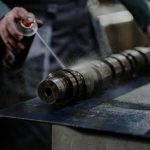To clean your faux leather sofa, start by vacuuming with a soft brush to remove dust. Mix mild dish soap with warm water and gently wipe the surface using a damp cloth—avoid soaking it. Rinse with a clean damp cloth, then dry thoroughly to prevent water spots. Blot spills immediately and use gentle methods for tough stains like ink or grease. Keep it away from heat and sun to avoid cracking. You’ll find more tips to keep your sofa looking great.
Table of Contents
Key Takeaways
- Regularly dust faux leather sofas with a soft, dry cloth to prevent dirt buildup and maintain appearance.
- Clean gently using a mild soap and warm water solution with a damp cloth, avoiding excess moisture.
- Remove tough stains by blotting, using rubbing alcohol for ink, or baking soda for grease stains, then dry thoroughly.
- Avoid harsh chemicals, abrasive scrubbing, and direct sunlight to prevent damage and cracking.
- Vacuum with a soft brush attachment and rotate cushions frequently for even wear and longevity.
Understanding Faux Leather and Its Care Requirements
Although faux leather looks like real leather, it’s made from synthetic materials designed to mimic its texture and appearance.
When you care for it, you need to remember it’s not as durable as genuine leather, so you should avoid harsh chemicals or abrasive scrubbing.
Faux leather resists stains better but can crack if it dries out, so keeping it clean and moisturized is essential.
Faux leather resists stains well but needs regular cleaning and moisturizing to prevent cracking and maintain its look.
You’ll want to use gentle cleaning products and avoid excessive water, which can damage the surface.
Regularly wiping down your sofa prevents dirt buildup, and knowing its material helps you pick the best cleaning approach.
Understanding these basics will help you protect your faux leather sofa, keeping it looking fresh and extending its lifespan.
Daily Maintenance Tips for Faux Leather Sofas
Daily maintenance plays an essential role in keeping your faux leather sofa looking its best.
Start by dusting it regularly with a soft, dry cloth to remove dirt and prevent buildup. Wipe spills immediately using a damp cloth to avoid stains. Avoid harsh chemicals or abrasive cleaners that can damage the material.
Keep your sofa away from direct sunlight and heat sources to prevent cracking and fading. Rotate cushions frequently to guarantee even wear. Use a mild soap solution occasionally, but make sure to test it on a hidden area first.
Finally, avoid sharp objects that could scratch or puncture the surface. By following these simple daily habits, you’ll extend your sofa’s life and maintain its stylish appearance effortlessly.
Step-by-Step Cleaning Process for Faux Leather Upholstery
When you’re ready to give your faux leather sofa a thorough clean, follow a simple step-by-step process to guarantee you don’t damage the material.
First, vacuum the sofa using a soft brush attachment to remove dust and debris from crevices.
Next, mix a few drops of mild dish soap with warm water. Dampen a soft cloth with the solution and gently wipe the surface, avoiding excessive moisture.
After cleaning, use a separate damp cloth with plain water to remove any soap residue.
Finally, dry the sofa thoroughly with a clean, dry towel to prevent water spots or damage.
This method keeps your faux leather looking fresh and prevents wear, ensuring your sofa stays comfortable and attractive for years.
Removing Tough Stains From Faux Leather
How do you tackle tough stains on your faux leather sofa without causing damage?
Start by blotting the stain gently with a clean cloth to absorb excess liquid—never rub, as that spreads the stain.
Gently blot stains with a clean cloth to soak up spills—avoid rubbing to prevent spreading.
For ink or marker spots, dab a cotton swab dipped in rubbing alcohol, testing first in an inconspicuous area.
For grease or oil stains, sprinkle baking soda, let it sit for 10 minutes, then wipe away with a damp cloth.
Use a mild soap solution for stubborn dirt, applying it sparingly with a soft cloth and rinsing with a clean damp cloth afterward.
Always dry the area thoroughly to prevent water damage.
Avoid harsh chemicals or abrasive tools that can strip the faux leather’s finish and cause discoloration.
Preventative Measures to Extend the Life of Your Faux Leather Sofa
Although faux leather is durable, taking simple preventative steps can greatly extend the life of your sofa.
Avoid placing it in direct sunlight or near heat sources, as this can cause cracking and fading.
Use a soft cloth to dust regularly and wipe spills immediately to prevent stains from setting.
Keep sharp objects away to avoid punctures or scratches.
Consider using a protective spray designed for faux leather to maintain its finish and repel dirt.
Rotate cushions periodically to guarantee even wear and prevent sagging.
Finally, maintain proper humidity levels in your home to prevent the material from drying out or becoming brittle.
Frequently Asked Questions
Can Faux Leather Sofas Be Repaired if Scratched or Torn?
You can repair faux leather sofas if they’re scratched or torn. Use a repair kit designed for faux leather, apply adhesive and a patch carefully, and follow instructions to restore your sofa’s look effectively.
Are Faux Leather Sofas Environmentally Friendly?
Imagine choosing a faux leather sofa that uses recycled materials—you’re making a greener choice than real leather. While not perfect, these sofas usually have a smaller carbon footprint and avoid animal cruelty, so they’re fairly eco-friendly.
How Does Faux Leather Compare to Genuine Leather in Durability?
You’ll find faux leather less durable than genuine leather since it can crack and peel over time. However, it’s easier to maintain and resists stains better, making it a practical choice for everyday use.
What Are the Best Brands for High-Quality Faux Leather Sofas?
You’ll want to check out brands like Article, Joybird, and West Elm for high-quality faux leather sofas. They offer stylish, durable options that won’t break the bank, ensuring comfort and lasting appeal.
Can Pets Damage Faux Leather More Than Other Materials?
Yes, pets can damage faux leather more than some materials because their claws might scratch or puncture the surface. You’ll want to trim their nails and use protective covers to keep your sofa looking great.
- What Is a Nonwoven Textile? a Broad Definition - July 9, 2025
- What Is a Nonwoven Textile? a Broad Definition - July 9, 2025
- What Is a Nonwoven Textile? a Broad Definition - July 9, 2025







